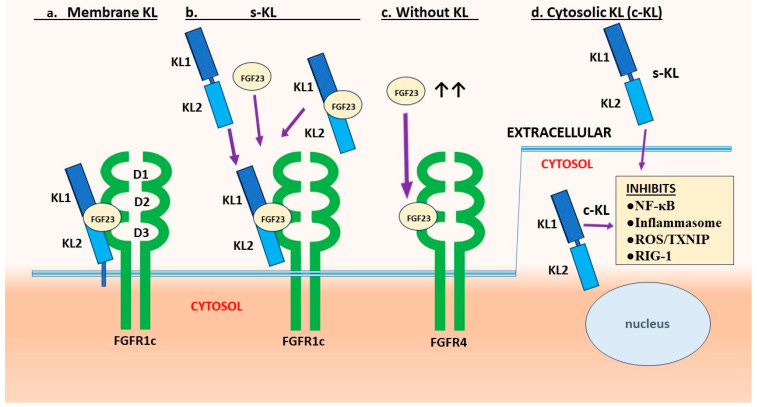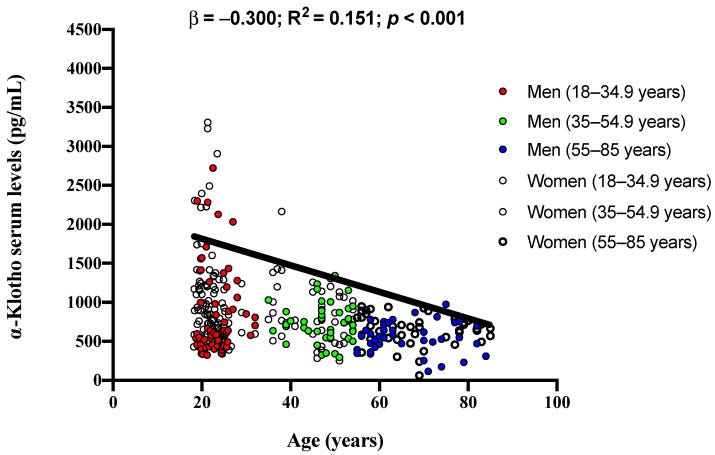For more than a decade, researchers have known that Klotho proteins are integral to healthspan. A 2011 study showed that plasma Klotho levels are an "independent predictor of all-cause mortality." Older individuals in the bottom quartile of Klotho levels had a 78% higher risk of death than those in the top 25%.[ref]
Recent studies show that Klotho is an important regulator of factors that are important in aging.
I’m going to go through some background on Klotho and how it mitigates age-related inflammation.
Background science on Klotho
Klotho proteins (αKlotho and βKlotho) are produced in the brain, kidneys, and a few other tissues. I’m going to focus primarily on αKlotho and just call it Klotho.
Rabbit trail: Klotho is named after one of the three Fates in Greek mythology, who was the spinner of the thread of life.
Klotho is found on the cell membrane and acts as a co-receptor that enhances the binding of fibroblast growth factors. It is also found in a soluble form that circulates in the bloodstream. [ref]
Let’s dive into the role of fibroblast growth factors first, and then we’ll come back to the soluble form.
Fibroblast growth factors (FGFs)
Fibroblast growth factors, FGFs, are a family of signaling proteins that control cell growth, tissue repair, development, and more.
The two Klotho proteins assist several FGFs in binding to their receptors to send signals to cells. [ref]
FGF21, a hormone secreted by the liver when not eating (starvation hormone), utilizes βKlotho when binding to its receptor. It acts on the HPA axis to induce the stress response.
FGF19 is a satiety hormone that is involved in appetite and metabolism. It also uses βKlotho.
FGF23 is a hormone produced by the bone marrow, and it utilizes Klotho (αKlotho) as a co-receptor. It plays an important role in how the kidneys regulate phosphate and calcium levels, as well as vitamin D metabolism.[ref][ref]
These three FGFs - and the systems they regulate - are an integral part of age-related disorders such as diabetes, atherosclerosis, and chronic kidney disease.
Klotho and phosphate/calcium regulation:
Phosphate is a nutrient that is used in the body in multiple ways. It is part of ATP production and DNA synthesis, and thus, we need to have a sufficient amount. However, we also don’t want too much phosphate. When phosphate levels are too high, FGF23 is secreted by the bone marrow and causes the kidneys to excrete more phosphate. FGF23 needs Klotho for this, so a lack of Klotho can cause excess phosphate. Higher FGF23 levels also reduce serum vitamin D levels as a way of regulating phosphate and calcium levels in the bone.[ref]

Here, we’re going to focus mainly on αKlotho (Klotho) and its role as an anti-aging molecule.
Soluble Klotho:
The kidneys are the primary source of its secretion into the bloodstream, which makes maintaining good kidney health important as we age.
It is thought that soluble Klotho also forms a complex with FGF receptors to improve the binding of FGF23 to its receptor. Thus, soluble Klotho plays an important role in regulating calcium, phosphate, and vitamin D levels. Low levels of soluble Klotho have been associated with the calcification of blood vessels and soft tissue, indicating dysregulation of calcium and phosphate.[ref][ref]
In kidney disease, damaged kidney tubular epithelial cells cannot release as much Klotho into the bloodstream. Consequently, most people with kidney disease have decreased Klotho levels, which allows for more oxidative stress and inflammation.[ref]
Soluble Klotho also binds to the FGF receptor 1c, which is expressed throughout the body, including in the endothelial cells that line the blood vessels.[ref]
Circulating Klotho also has anti-inflammatory properties by activating Nrf2 and inhibiting the NLRP3 inflammasome. Activation of Nrf2 increases the expression of endogenous antioxidants, such as SOD1, CAT, and NQO1. Conversely, the NLRP3 inflammasome is a signaling pathway that increases inflammatory signaling. This is beneficial when fighting off a virus, but detrimental when dealing with chronic inflammation associated with aging. Thus, Klotho’s role in modulating NLRP3 leads to an overall reduction in chronic inflammation, while Nrf2 upregulation increases antioxidants.[ref][ref]
Related Longevity Lifehacks article: NLRP3 activation as a driving factor in Alzheimer's
Circulating soluble Klotho also blocks the TGF-beta receptor, which helps to prevent fibrosis.

Klotho levels are typically high in cerebrospinal fluid and play a role in insulin signaling in the brain. One study of healthy adults found that higher Klotho levels in older adults are associated with better cognitive function.[ref]
Klotho in aging:
Klotho levels decline with age, and the extent of the decline correlates with overall health and resilience in aging.
When you look at health issues associated with getting older, you’ll see that Klotho interacts with many of them. Calcification of blood vessels (hardening of the arteries), cardiac hypertrophy, CAD, kidney dysfunction, decreased metabolism, and bone degeneration are all integral to low Klotho.[ref][ref]
Let’s take a look at a few of the recent studies:
One study involving 345 adults aged 18-85 showed that serum Klotho levels decline linearly with age.[ref]
In people with chronic kidney disease, a meta-analysis showed that patients with lower soluble Klotho levels had an 88% increased risk of all-cause mortality.[ref]
Another study showed that low Klotho levels were associated with increased relative risk of aortic calcification, cardiac hypertrophy, and cardiovascular mortality.[ref]
Can Klotho be too high? Excess Klotho is associated with liver fibrosis, so you may not want excessively high Klotho levels either (although the mechanism here isn’t clear). A recent study showed that it’s a U-shaped curve for the right serum Klotho levels.[ref]

What can you do to increase Klotho?
First, having good kidney function is important for Klotho levels. Avoiding smoking, excess alcohol, and high blood pressure helps to keep your kidneys healthy. Diabetes and obesity are also hard on the kidneys. Long-term use of NSAIDs can also damage the kidneys.[ref]
In addition to kidney health, diet, lifestyle, and supplements may help to increase Klotho levels.
Exercise - maybe: In middle-aged adults, exercise increases Klotho levels.[ref]
However, a clinical trial in adults over age 65 did not show that exercise increased Klotho levels.[ref]
Cordyceps mushroom extract: A cell line study using kidney tissue showed that Cordyceps sinensis increases Klotho levels.[ref]
Cordyceps is available as a powder* or in capsules. I sometimes add it to a smoothie or even to coffee (it’s a bit grainy and earthy in coffee, but not terrible). Look for a product that has 3rd party testing for purity and heavy metals.
Magnesium: Phosphorus, calcium, and magnesium levels are all related. In animals, a low-magnesium diet decreases Klotho expression in the kidneys.[ref] A study in adults showed that low magnesium levels are also associated with decreased Klotho concentrations.[ref] While I didn’t find any clinical trials using magnesium to increase Klotho, I think the takeaway here is that maintaining good magnesium levels helps to maintain Klotho levels. Foods high in magnesium include leafy greens, nuts, pumpkin seeds, black beans, shredded wheat, yogurt, milk, avocados, bananas, papayas, and potatoes with the skin.
Magnesium supplements are also available* if you are low.
Probiotics: A probiotic containing Lactobacillus acidophilus and Bifidobacterium bifidum prevents the age-related decline in Klotho levels in mice.[ref]
Healthy diet: A study using the Alternative Healthy Eating Index showed that Klotho levels increase linearly with a healthy diet. The Alternative Healthy Eating Index scores the diet based on DHA/EPA, vegetables, fruits, whole grains, nuts, and legumes as positives, along with low levels of trans fats, processed meats, sugar-sweetened beverages, and alcohol.[ref] Along the same lines, a diet that is higher in vitamin C (and thus higher in fruits and vegetables) is also associated with higher Klotho levels.[ref]
Mediterranean diet: A 2022 paper showed that eating a Mediterranean Diet increased soluble Klotho levels. They defined a Mediterranean diet as one that included a lot of “fruit, vegetables, legumes, cereals, fish, meat and meat products, dairy products, [moderate] alcohol, and olive oil.”
Dasatinib plus Quercetin: The combination of Dasatinib plus Quercetin is used as a senolytic to clear out senescent cells. The signals given off by senescent cells cause Klotho to decrease. Removing senescent cells increases Klotho. In this study, Dasatinib plus Quercetin were used to target senescent cells, and the results showed that it increased Klotho both in mice and in humans.[ref]
Resveratrol: A study of 80 people with hypertension showed that 400 mg/day of resveratrol in addition to their regular medications helped to improve arterial stiffness. What was interesting is that both Klotho and SOD levels increased only in the resveratrol arm of the study.[ref]
What about phosphate? Phosphate, calcium, and vitamin D are all intertwined with Klotho. Excess phosphate increases FGF23 and the need for Klotho as a coreceptor. In people with kidney disease, a low phosphate diet is often recommended. I’m not finding a lot of research showing that a low phosphate diet is beneficial for increasing Klotho in aging. However, there are animal studies showing that a high phosphate diet may be a problem in aging.[ref] Balance may be needed. Foods highest in phosphate additives include processed food, colas, and processed meats.
Conclusion:
Klotho is an interesting protein that holds promise for healthy longevity. Researchers are actively looking at ways to increase Klotho levels with medications - or with a patented human Klotho protein.[ref] I expect to see a lot more research on Klotho and aging over the next few years.
*Amazon affiliate link. These are just suggestions of brands that I’ve used before, but there may be better options out there. Read reviews and choose a supplement that you’re most comfortable with.





